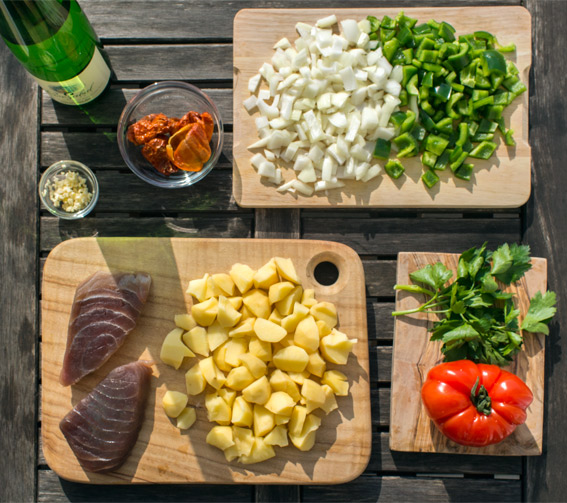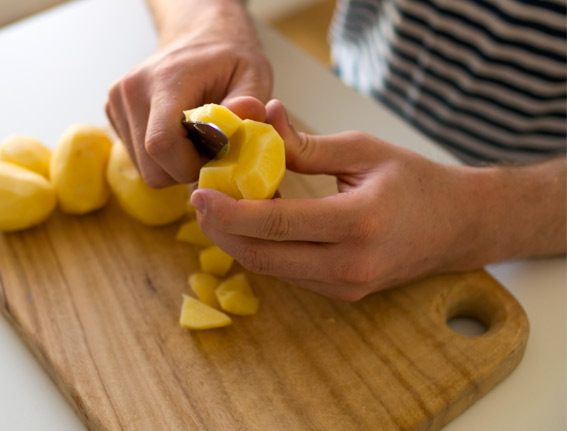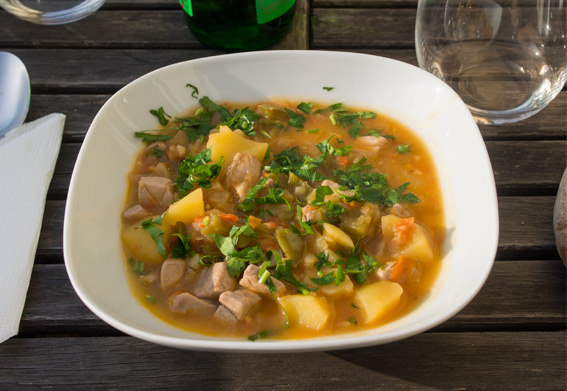Before it made its way into Basque kitchens, marmitako was a typical meal for Basque fishermen and was prepared while they were on their boats, in search of tuna. Contrary to what one might think, it was traditionally a meal eaten in summer due to the simple fact that the warmer months are when the tunas are out. If it is particularly hot out, the marmitako can also be eaten when it is lukewarm. But it’s so good, I’m sure it can even be eaten cold!
 Marmitako Ingredients
Marmitako Ingredients
Before we get started with the recipe, I just wanted to make one quick note about the pimientos choriceros. These are dried red peppers that are very typical in Basque cooking and can be difficult to find outside of the Basque Country. In fact, I noticed that all of the recipes for marmitako that I found online in English, don’t even use it. Instead, they just add in normal red pepper. While this can be done and it will taste good, it won’t be AS GOOD as it would with the pimientos choriceros. It would be like substituting a sun dried tomato for a normal tomato. I have looked online and found that it can be purchased outside of Spain. It is usually called “carne de pimiento choricero” and comes in a jar. If you plan on making other Basque dishes or are just serious about your marmitako, I would highly recommend grabbing a bottle. It is really awesome stuff.
Here is a link I found for an online store that sells the carne de pimiento choricero. In Europe, it is more readily available but you might still have to find a place online to order it. Or pick up a bottle when you are visiting the Basque Country.
The only other part of the recipe that could be new for you is the breaking of the potato instead of slicing it. The breaking can be done by inserting the knife into the potato just a little bit and then twisting the blade so that it breaks off little chunks of potato. This is important because it preserves the natural structure of the potato and helps the sauce become more starchy and thick without the need to add a thickening agent.
 Breaking potato into small chunks
Breaking potato into small chunks
Ok, on to the recipe!
Ingredients (for 2 people)
200g tuna fish (1/2 pound) | 1 small onion | 1 green pepper | 2 large potatoes | 1 clove of garlic | 1-2 dried pepper (pimiento choricero) | 1 small tomato (optional) | parsley | olive oil | txakoli (white wine) | water | salt
1. Cut the vegetables into small pieces. Potatoes need to be peeled and then broken, not sliced.
2. Lightly sauté the onion with some oil until they start to become translucent.
3. Add green pepper, let cook for some minutes.
4. Add potatoes & garlic and let cook for a few more minutes.
5. Add wine (I like to use a fair amount, around 1 cup)
6. Add pimientos choriceros – either add a few tablespoons of the paste from a jar or if you have used real pimientos choriceros, have them soaking in water beforehand until they expand, then cut the meat of the pepper off and get rid of the pepper’s skin.
7. Add water and make sure the level is high enough to cover the vegetables inside.
8. Add salt
9. Cover and let cook slowly, stirring occasionally. Add more water if/when needed.
10. If you want to use tomato, add it towards the end. I use a cheese grater for mine and make it into a salsa before I add it.
11. Once the potatoes are cooked, the marmitako is essentially finished. Add cubes of tuna and cook for 2-3 minutes.
12. Serve marmitako and sprinkle with fresh parsley.
 Finished dish of marmitako
Finished dish of marmitako
Enjoy with your bottle of white wine!



looks delicious! very interesting about the potatoes. do you think it could be made with a different kind of white wine if txakoli isn’t available? thank you!
Hi Megan, thank you very much for your comment! Yes, why not, I think that you can try with a different kind of white wine. Maybe try with a wine that is not so sweet? I think that a Chardonay would be a good option. It may even be good with a sweet white wine. I’m sure it won’t be bad, for sure just different 🙂 Let us know about your results!
Hello Patricia! I am glad I found this recipe. I am in the process of launching a food blog and I would rather make than purchase specialty ingredients. I am curious about pimientos choriceros. is it hot? sweet? smoky? Do you know what the genus sp. of the pepper is? is the paste similar to Harissa http://www.recipesource.com/side-dishes/sauces/09/rec0947.html or shatta http://www.recipesource.com/side-dishes/sauces/04/rec0499.html I appreciate any information you can give. thanks!
Hello Luma, thanks for your comment! The pimientos choriceros aren’t hot or smoky, maybe a little bit sweet, but just a little. They just have a very characteristic taste that is very difficult to explain… Maybe it will help you to know that they are of the species Capsicum annuum (https://en.wikipedia.org/wiki/Capsicum_annuum). However, I think that you didn’t understand what the “carne de pimiento choricero” is. “Carne” means “meat” in Spanish and when you buy the paste of “carne de pimiento choricero” what you get is just that, the meat of the pepper, no other spices or ingredients are added. It is just a way to pack and store them easier. If you don’t have pimientos choriceros but have the option to buy the paste, I highly recommend it or it will be very difficult to give the dish the “correct” (relatively speaking) taste. We wish you luck with your new blog!
Hi, just to say that in Spain we use Spanish sweet paprika if we don’t have “pimientos choriceros”. Any light dry and fruity white wine should do the trick. Thanks for the recipy.
Javier
Excellent! I am so glad that you went on to explain why the potatoes are broken instead of sliced because I saw that on an episode of Junior Masterchef Spain and wondered what was the purpose of doing so. I only sourced the pimiento choricero after I tried your recipe (that tip by Javier was invaluable) so look forward to trying it again!
With a marmitako I would serve Cava, a Mestres Bluefin. It was made to accompany tuna!
The link for Doña Juana (to buy pimiento choricero) is no longer available.
Thanks for your comment David! We have proceeded to update the link, it is working now.